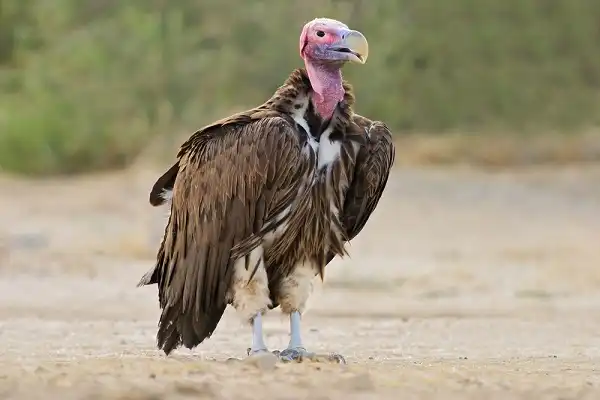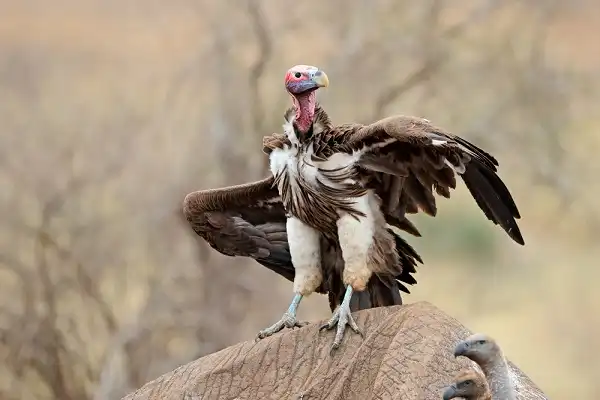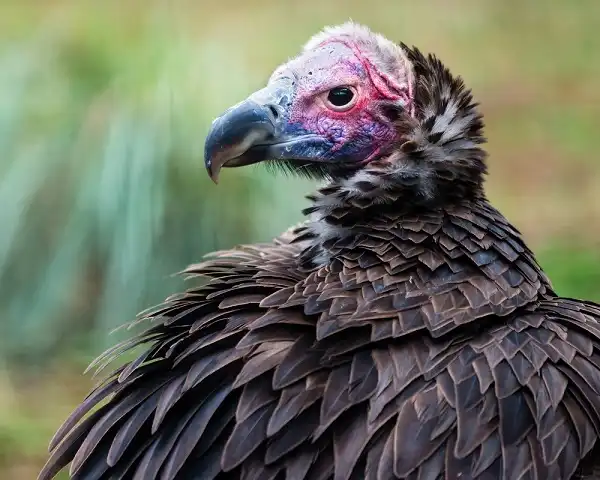Vultures are among some of the most under-appreciated birds in the world. Though they may not have a reputation for being particularly beautiful, they play an integral role in keeping our environment—specifically those ecosystems with large mammal populations—healthy by scavenging and dispersing animal carcasses. One species of vulture that is especially remarkable is the Lappet Faced Vulture (Torgos tracheliotus); its size, striking features, and global range make it one of the more fascinating members of this family of birds. In this blog post, we will explore the characteristics that make up this incredible bird and why conserving it should be a priority!

Lappet Faced Vulture Description
The Lappet Faced Vulture is a large bird. They are easily distinguished by their unique head features; they have feathered, lappet-shaped ear tufts, as well as a fleshy crest on the back of their neck. Their plumage is usually dark with white patches around the face, belly, and wingtips. They have a distinctive long neck and bald head, as well as prominent white feathers on the back of their neck that give them their name. These vultures have dark grey plumage covering the majority of their body which helps them blend into their environment when perched atop trees. The importance of this species should not be underestimated; it plays an essential role in keeping our environment healthy by breaking down animal carcasses that may otherwise spread disease or contaminate water supplies if left untreated. Furthermore, they are also important indicators of health within an ecosystem since they rely heavily on large mammal populations which means that if their numbers start to decline then there may be other problems at play within the environment that should be addressed as soon as possible.
Lappet Faced Vulture Habitat
The natural habitat of the Lappet Faced Vulture can be found across a wide expanse of land, ranging from the African continent to parts of South Asia. They are typically found in dry open woodlands, grasslands, and scrublands that provide ample space to hunt for food. They also tend to congregate in large flocks when searching for carrion, which is their primary source of sustenance. These vultures prefer to live in areas that have an abundant supply of large mammals, such as antelopes, zebras, and wildebeests. This is because these animals often leave behind carcasses that can be scavenged by the birds.
Lappet Faced Vulture Diet
The Lappet Faced Vulture is an opportunistic feeder, primarily relying on carrion from the remains of large animals for sustenance. They also supplement their diet with small vertebrates such as reptiles, amphibians, and rodents. These birds are very resourceful and can go for long periods without eating if necessary by relying on stored energy reserves in the form of fat. In addition to its primary food sources, the Lappet Faced Vulture also scavenges for other food items including eggs and chicks from other birds’ nests; it has even been observed harassing flamingoes and geese to steal their fish! The vultures have also been known to attack wounded or injured animals while they are still alive to feed on them more easily. Of particular importance to the species is its ability to compete with other scavengers such as jackals and hyenas. By having a wide range of food items available to them these vultures can ensure that they have access to adequate amounts of nutrition when other scavengers may be competing for the same carcass.

Lappet Faced Vulture Size
The Lappet Faced Vulture is a large bird of prey, with adults typically measuring between 28 and 34 inches in length and weighing around 6-7 kilograms. Their wingspan can measure up to 1.8 meters, enabling them to soar effortlessly over wide expanses of land in search of food. However, although this species is generally quite large it is still smaller than other Old World vultures such as the Griffon Vulture or Cinereous Vulture which can reach up to 2 meters in length! Furthermore, the Lappet Faced Vulture has relatively short legs which prevent them from standing upright like many other birds of prey.
Lappet Faced Vulture Lifespan
The lifespan of a Lappet Faced Vulture varies significantly depending on the region in which they live. In the wild, these birds typically live between 15 and 20 years, while in captivity they can live up to 40 years. To achieve such a long lifespan, the vultures must be able to survive against predators, disease, and other environmental conditions. In general, these birds tend to prefer more arid areas with high elevations for nesting and roosting; this is likely due to their preference for wide open spaces with minimal competition from other scavengers. All of these factors help the vultures live longer lives and ensure their preservation for future generations. Unfortunately, however, this species faces many threats in its natural habitat including habitat destruction and hunting by humans; as a result, their population has seen a dramatic decline over the last few decades. As such it is important that we work together to protect this species so that it may continue to thrive in its natural environment.
Lappet Faced Vulture Behavior
The Lappet Faced Vulture is a sociable bird, often forming large colonies that can contain up to hundreds of individuals. They are also quite vocal and have a distinct call which is used to alert other members of the flock when food sources are located. In addition, they use their powerful wings to soar over vast distances in search of carrion which makes them essential scavengers within their ecosystem; without their presence diseases could spread quickly among local populations, and water sources could become contaminated due to putrefying remains. The vultures are also highly protective of their nesting sites and will aggressively defend them from intruders; this behavior often leads rival species to stay away from these areas as the vultures are capable of causing serious injury to potential predators.

Lappet Faced Vulture Speed
The Lappet Faced Vulture is an impressive bird of prey that is capable of incredible speeds and aerobatics. In flight, these birds can reach speeds of up to 95 mph (153 kph); this makes them one of the fastest birds in the world, rivaling even some species of falcons and other raptors. When hunting, the vulture maneuvers its large wingspan to make tight turns and sudden dives to capture unsuspecting prey; these aerial acrobatics are believed to be a major factor in its success as a predator. Additionally, when migrating these birds often fly at great altitudes; they have been known to reach heights of up to 30,000 feet (10 km) above sea level! In addition to their impressive speed and maneuverability, the vultures also possess remarkable endurance. They can travel long distances without needing to rest, allowing them to cover vast areas in search of food sources; they have been known to traverse entire continents in a single day!
Lappet Faced Vulture Hunting
The Lappet Faced Vulture is an incredibly effective hunter, adept at soaring through the air to locate potential prey. To hunt, they will locate a potential food source and then swoop down in a series of fast, powerful dives; using their sharp talons and hooked beak to capture their quarry. These vultures are also scavengers, eating carrion when available; this helps them take advantage of the most readily available sources of food in their ecosystem. They are especially fond of ungulates such as antelopes or wildebeests which can provide them with plenty of sustenance. In addition to hunting for food, the Lappet Faced Vulture also defends its young from predators by driving away intruders from its nesting sites. They have even been known to attack animals such as lions or hyenas when defending their offspring; showing just how devoted and courageous these birds can be.

Conclusion
The Lappet Faced Vulture is a remarkable bird of prey that plays an essential role in many African ecosystems. Its impressive speed and agility make it an incredibly effective hunter and scavenger, ensuring its survival for future generations. Furthermore, the aggressive defense of its nesting sites from intruders helps maintain the balance of nature by keeping rival species away. It is therefore important that we do what we can to protect their habitats so that this species may remain a vital component of many African ecosystems for years to come. By doing so, not only will the vultures be able to continue thriving in their natural environment but the entire ecosystem will benefit as well.
Frequently Asked Question

